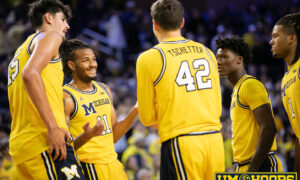On March 23rd, Michigan hired Florida Atlantic’s Dusty May and kicked off a new era of the basketball program. May has rebuilt the roster and re-tooled the program with an impressive coaching staff, but his first game on November 4th is still weeks away. We know the basics about May’s resume, the highlights of his FAU team’s success, and what he’s said in press conferences, but there’s still much more to uncover.
We’ve spent the summer digging into May’s game film, press conferences, interviews, clinic videos and more to understand his basketball vision and how that applies in Ann Arbor. Over the next two months, we’ll look closer at May, his philosophy, and his track record in a series of bite-sized breakdowns that feature everything from on-court tendencies to sideline demeanor to analytics, schematics, and culture building.
Welcome back to Dusty 101. Today we break down May’s approach to shot selection. (Previously: Offensive philosophy)
There’s a point in sports when a popular statistic or idea reaches a cultural meaning beyond the original intention. It’s hard to talk about basketball in 2024 without hearing buzzwords like shot quality, death of the mid-range, shot profile, dunks and threes, make-or-miss league, or something in between.
We reach this awkward in-between phase where a statistic is arguably the single most important thing that a coaching scheme can control on a basketball court. However, the stat is still used incorrectly in countless other irrelevant arguments.
Taking better shots than your opponent over a 40-minute game doesn’t mean you will win the game — or should have won the game — but taking higher-value shots throughout an entire season gives your offense a chance to be more efficient and win a lot more games than the alternative.
Everyone agrees that some shots are more valuable than others, but different coaches emphasize and instruct their players differently to produce those shots. Dusty May has outlined his philosophy on shot selection in several different clinics, and the hierarchy is simple and to the point.
“We’re not like huge analytics people,” Kyle Church said at a clinic last year. “But our team really understands what’s good for us, what’s good for our team.”
Mostly, May’s program takes a practical but realistic approach and prioritizes four types of shots, in this order:
- Free Throws
- Dunks & Layups: “Not a paint shot, a rim shot.”
- Catch & Shoot Threes
- ‘Mastery Shots’: Proven with regularity that a player can make in practice
Dusty May Promo!
Join the UM Hoops Community
Join the only community dedicated to Michigan basketball
Get ad-free articles, recruiting, advanced stats, member-only discussion, and the most complete Michigan hoops analysis anywhere.
Already a member? Log In









